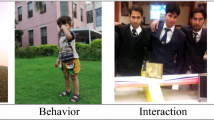Abstract
The future of human computer interaction systems lies in how intelligently these systems can take into account the user’s context. Research on recognizing the daily activities of people has progressed steadily, but little focus has been devoted to recognizing jointly activities as well as movements in a specific activity. For many applications such as rehabilitation, sports medicine, geriatric care, and health/fitness monitoring the importance of combined recognition of activity and movements can drive health care outcomes. A novel algorithm is proposed that can be tuned to recognize on-the-fly range of activities and fine movements within a specific activity. Performance of the algorithm and a case study on obtaining optimal features from sensor and parameter values for the algorithm to detect fine motor movements are presented.




















Similar content being viewed by others
References
Activity Recognition and Vital Sign Monitoring, Cyber-Physical Systems (CPS) Lab, Rutgers University. http://nsfcac.rutgers.edu/CPS/demo.html
Albinali F, Goodwin MS, Intille SS (2009) Recognizing stereotypical motor movements in the laboratory and classroom: a case study with children on the autism spectrum. In: Proceeding of international conference on ubiquitous computing. Orlando, Florida
Anliker U, Ward J, Lukowicz P, Trster G, Dolveck F, Baer M, Keita F, Schenker E, Catarsi F, Coluccini L, Belardinelli A, Shklarski D, Alon M, Hirt E, Schmid R, Vuskovic M (2004) Amon: a wearable multiparameter medical monitoring and alert system. IEEE Trans Inf Technol Biomed 8(4):415–427
Bao L, Intille SS (2004) Activity recognition from user-annotated acceleration data. In: Proceeding of pervasive computing (PERVASIVE). Vienna, Austria
Barry M, Gutknecht J, Kulka I, Lukowicz P, Stricker T (2005) From motion to emotion: a wearable system for the multimedial enhancement of a butoh dance performance. J Mobile Multimedia 1(2):112–132
Bourke A, OBrien J, Lyons G (2007) Evaluation of a thresholdbased tri-axial accelerometer fall detection algorithm. Gait Posture 26(2):194–199
Christopher J, Burges C (1998) A tutorial on support vector machines for pattern recognition. Data Min Knowl Discov 2(2):121–167
Feng L, Yueting Z, Fei W, Yunhe P (2003) 3D motion retrieval with motion index tree. Comput Vis Image Underst 92(2):265–284
Ghasemzadeh H, Barnes J, Guenterberg E, Jafari R (2008) A phonological expression for physical movement monitoring in body sensor networks. In: Proceeding of mobile Ad-hoc and Ssnsor systems (MASS). Atlanta, GA
Gidudu Anthony HG, Tshilidzi M (2007) Image Classification Using SVMs: one-against-one vs one-against-all. In: Proceedings of Asian conference on remote sensing (ACRS). Kuala Lumpur, Malaysia
Gu T, Wu Z, Tao X, Pung HK, Lu J (2009) epsicar: an emerging patterns based approach to sequential, interleaved and concurrent activity recognition. In: Proceedings of pervasive computing and communications (PerCom). Galveston, Texas
Heinz EA, Kunze KS, Junker SSH, Lukowicz P, Troster G (2003) Experimental evaluation of variations in primary features used for accelerometric context recognition. In: Proceedings of European symposium on ambient intelligence (EUSAI). Eindhoven, The Netherlands
Jafari R, Li W, Bajcsy R, Glaser S, Sastry S (2007) Physical activity monitoring for assisted living at home. In: Proceedings of international workshop on wearable and implantable body sensor networks (BSN). Germany
Kasteren TV, Noulas A, Englebienne G (2008) Accurate activity recognition in a home setting. In: Proceeding of international conference on ubiquitous computing. Seoul, South Korea
Kern N, Schiele B, Schmidt A (2003) Multi-sensor activity context detection for wearable computing. In: Proceedings of European symposium on ambient intelligence (EUSAI). Eindhoven, Netherlands
Liao L, Fox D, Kautz H (2005) Location-based activity recognition. In: Proceedings of neural information processing systems (NIPS). British Columbia, Canada
Liszka K, Mackin MA, Lichter MJ, York DW, Pillai D, Rosenbaum DS (2004) Keeping a beat on the heart. IEEE Pervasive Comput 3(4):42–49
Liu J, Wang Z, Zhong L, Wickramasuriya J, Vasudevan V (2009) uwave: accelerometer-based personalized gesture recognition and its applications. Pervasive Mob Comput 5(6):657–675
Muller M, Rder T, Clausen M (2005) Efficient content-based retrieval of motion capture data. ACM Trans Graph 24(3):677–685
Ravi N, Dandekar N, Mysore P, Littman ML (2005) Activity recognition from accelerometer data. In: Proceeding of American association for artificial intelligence (AAAI). Pittsburgh
Shimmer: http://shimmer-research.com
Stiefmeier T, Roggen D, Ogris G, Lukowicz P, Trster G (2008) Wearable activity tracking in car manufacturing. IEEE Pervasive Comput 7(2):42–50
Varkey JP, Pompili D (2009) Movement recognition using body area networks. In: Proceedings of IEEE global telecommunications conference (GLOBECOM). Honolulu, HW
Villalba E, Ottaviano M, Arredondo M, Martinez A, Guillen S (2006) Wearable monitoring system for heart failure assessment in a mobile environment. Comput Cardiol 237–240
Walls T (in press) Intensive longitudinal data. In: Little T, Nathan P (eds) Models for intensive longitudinal data. Oxford University Press, Oxford
Walls T, Schafer J (2006) Introduction. In: Walls T, Schafer J (eds) Models for intensive longitudinal data. Oxford University Press, New York, pp ix–xi
Wang L, Gu T, Chen H, Tao X, Lu J (2010) Real-time activity recognition in wireless body sensor networks: from simple gestures to complex activities. In: Proceedings of embedded and real-time computing systems and applications (RTCSA). Macau SAR, PRC
Author information
Authors and Affiliations
Corresponding author
Rights and permissions
About this article
Cite this article
Varkey, J.P., Pompili, D. & Walls, T.A. Human motion recognition using a wireless sensor-based wearable system. Pers Ubiquit Comput 16, 897–910 (2012). https://doi.org/10.1007/s00779-011-0455-4
Received:
Accepted:
Published:
Issue Date:
DOI: https://doi.org/10.1007/s00779-011-0455-4




